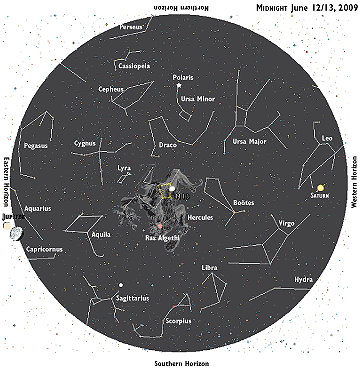
Volume XVII, Issue 23 # June 4 - June 1, 2009 |
 |
 |
Sky Watch
by J. Alex Knoll
What the Witching Hour Reveals
For one moment, the universe holds its breath
As the sun sets around 8:30, the first star you see is more likely Saturn, high in the southwest, and the brightest light in the sky until moonrise.
The waning gibbous moon rises at the witching hour separating Friday from Saturday. Minutes later, Jupiter appears, trailing behind three degrees. By daybreak, around 6:00, the two hang about 25 degrees above the southern horizon. The next morning, the moon rises a half-hour later, and now Jupiter leads the way by not quite 10 degrees.
At midnight this week, look directly above you for the constellation Hercules. While none of its stars shine brighter than second magnitude, Hercules contains countless stars, some more than 8 billion years old, which allow astronomers to delve into the infancy of the universe.
Hercules hangs upside-down, his feet to the north with one atop the head of Draco the dragon. Four stars form his torso, called the keystone of Hercules. The red-hued star Ras Algethi, which in Arabic means the kneeler’s head, marks Hercules’ head. While this dim star 380 light years distant isn’t much to look at, it is one of the largest stars known, a red giant 500 times more massive than our sun. Were it the center of our solar system, its girth would reach beyond Mars.
Look closely alongside the western edge of the keystone for a dim fuzz of light. Just visible to the unaided eye, the globular cluster M13 contains more than 300,000 stars and is the brightest globular cluster visible in the northern hemisphere. In 1974, M13 became the target for the first radio message sent to possible extra-terrestrials. Traveling at the speed of light, it should reach them around the year 24,974.
Illustration: © Copyright 1925 M.C. Escher/Cordon Art-Baarn-Holland; Graphics: © Copyright 2009 Pacific Publishers. Reprinted by permission from the Tidelog graphic almanac. Bound copies of the annual Tidelog for Chesapeake Bay are $14.95 ppd. from Pacific Publishers, Box 480, Bolinas, CA 94924. Phone 415-868-2909. Weather affects tides. This information is believed to be reliable but no guarantee of accuracy is made by Bay Weekly or Pacific Publishers. The actual layout of Tidelog differs from that used in Bay Weekly. Tidelog graphics are repositioned to reflect Bay Weekly’s distribution cycle.Tides are based on National Oceanic and Atmospheric Administration and are positioned to coincide with high and low tides of Tidelog.
